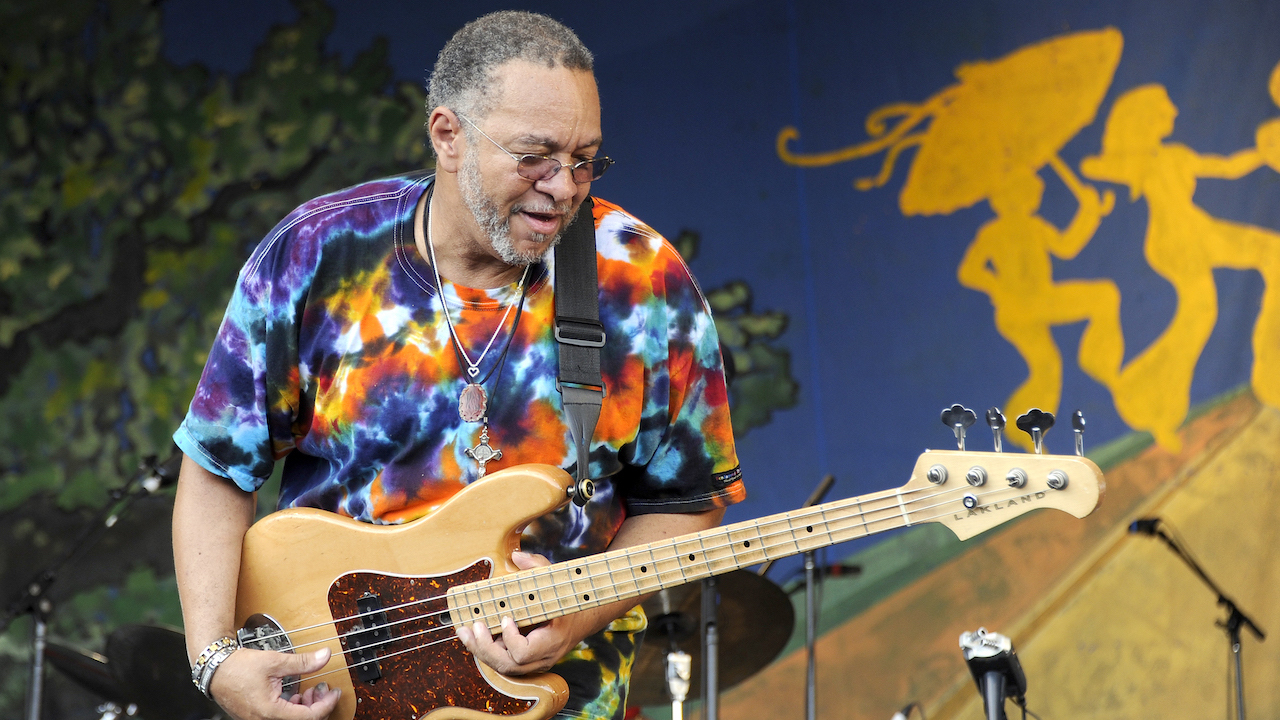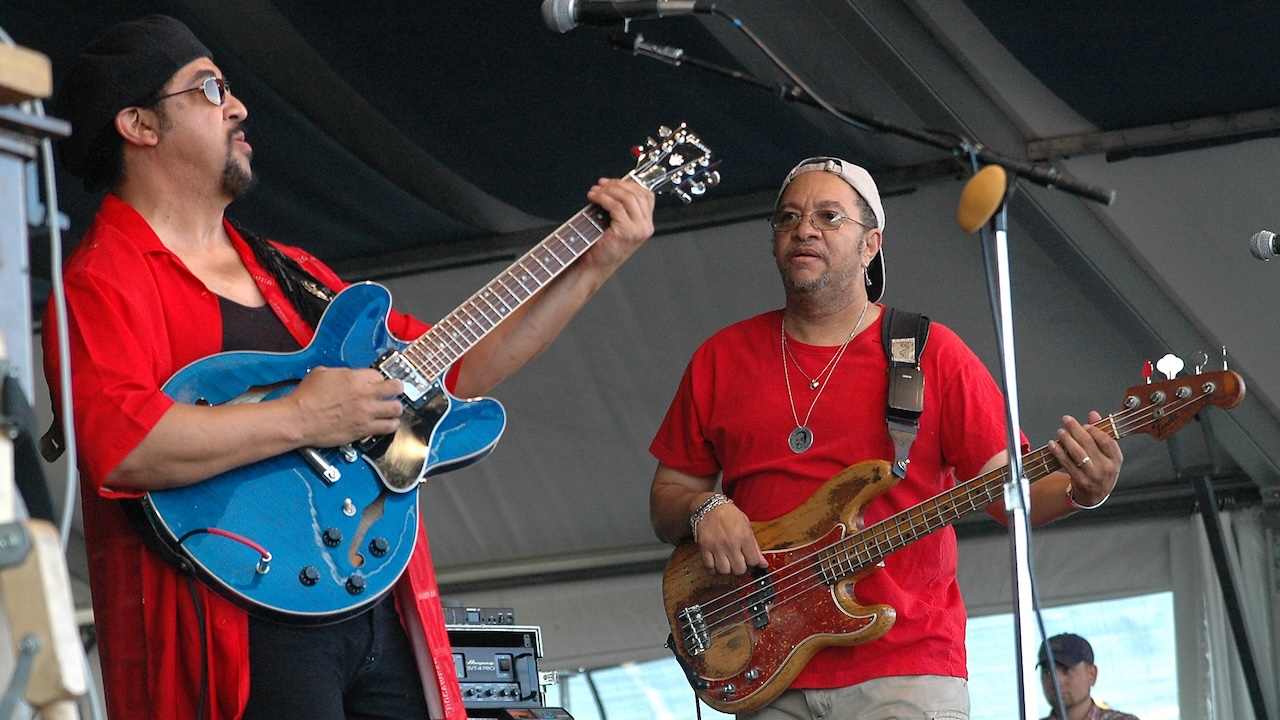
George Porter Jr. epitomises New Orleans funk bass. Just as Donald ‘Duck’ Dunn embodies Memphis R&B, or James Jamerson defines Detroit's Motown sound, Porter's playing is so intrinsic to a particular musical vernacular, it's impossible to imagine it originating anywhere else.
Porter's style is also inseparably linked to his work with the Meters, perhaps New Orleans' most influential musical act since Louis Armstrong.
Porter wove his broad basslines seamlessly into Drummer Joseph ‘Zigaboo’ Modeliste's deep-fried pockets, resulting in a distinctly down-home approach to funk that's diametrically different from the backbeat-driven styles of James Brown, Sly & the Family Stone, and P-Funk, which Porter claims didn't influence him at all.
“I grew up listening to mostly regional music, which was on the radio more than outside stuff,” Porter told Bass Player. “I heard jazz, Fats Domino, Earl King, and, during Mardi Gras, Professor Longhair.”
Porter began playing piano, gravitated to guitar, and in 1965 got a call from a local star, singer/keyboardist Art Neville. “Art depended on the guitar player to play solos, and I couldn't solo. About a year later, he saw me playing bass with Irving Banister, and Art said, 'That's the instrument you should be playing. Do you want a gig?' That was the beginning of the Meters.”
Guitarist Leo Nocentelli was already in the fold, and when Modeliste (who is Porter's cousin) joined on drums, a magical chemistry developed. The Meters honed their sound in the studio backing regional stars including Lee Dorsey and Betty Harris; they worked under the direction of producer/songwriter Allen Toussaint, in similar fashion to Dunn's experience with Booker T. & the MG's, and Jamerson's with the Funk Brothers.
“In the beginning, most of our music was written from jams. Zig or Leo would usually throw a lick on the table, and everybody would put in a line – almost like in bebop and we'd refine it into a song. What we created later – You've Got to Change (You've Got to Reform), Africa [famously covered by the Red Hot Chili Peppers on Freaky Styley], and Ain't No Use – began as jams, and then Leo or Zig went home and wrote words.
“When the real songwriting started to happen, certain parts were spelled out for us to play, but it was up to the player to make the part his own and form a bind with the other parts.”
What made the Meters the Fab Four of Funk was their ability to transcend supporting status and produce their own instrumental hits, eventually growing into a songwriting team capable of writing vocal hits. It began innocently enough.
“After Toussaint left the studio one day, his manager Marshall Sehorn said, ‘Why don't y'all lay down some stuff?’” That session, recorded at Jazz City studios, yielded the band's first single, Sophisticated Cissy, and the signature hit Cissy Strut, both issued on the band's eponymous 1969 debut.
The Meters reached a broader audience with vocal tunes such as Hey Pocky A-Way and Fire on the Bayou, and the Rolling Stones brought them along on their 1975-76 world tour, which proved to be the height of Meters mania.
Among Porter’s most dense lines is the intro and verse groove to the late-period Meters track Funkify Your Life. Clicking on an envelope filter and using his unusual slap technique, which incorporates dug-in fingerstyle snaps instead of plucked pops, Porter creates a 16th-note funk masterpiece.
“I play with my thumb when I want a fatter sound, and I move toward the neck to get the real fat bottom end – that deep ballad sound. I move back behind the pickup when I want to get that ‘gonk’ but still with a fat sound.
“My fingers are not as bottom-heavy as my thumb, but my fingers are fast – although I'm pretty quick with my thumb, too. But I can't slap because I have weak wrists. Snapping the string sort of gives you that slap effect, but it's absolutely different. It's not as rhythmic, but it works for accents.”
Cissy Strut is perhaps the Meters’ most recognisable tune, and it’s an excellent example of Porter’s early-period style. Played unison with guitarist Leo Nocentelli, the classic opening line’s crisp execution is definitive Meters.
“Technical musicians might be able to spell it all out in print, but if the pocket isn't there, it's just dots on paper. We played off Zigaboo's grooves and Leo's rhythms. My job as a bass player was to tie those two pieces together, so that when Art went to do his thing, he had this pocket.”
When time expired on the Meters in 1977, the group’s mystique continued to grow through hip-hop samples and the expanding jam-band scene. “Hip-hop is great; it takes some thinking, and if you hired me, I would gladly come do a session. But don't rip off my performance from a song I co-wrote and then take me to court with a countersuit saying. ‘You're creating issues with my music.’ It ain't your music, it's my music!
“Me and that don't get along – in fact, it pisses me off! Maybe two percent of all the samples out there are legal, and that's fine. Then there are the 30 or 40 percent who get caught. You've got to fight them for two or three years, and by that time, they're broke.”
In 2000, the Meters played a single reunion show in San Francisco, and the four finally reconvened for a set at the 2005 New Orleans Jazz And Heritage Festival, which led to more dates. Even Hurricane Katrina couldn't hold them back.

“I played at the Maple Leaf with Teresa Anderson for Midsummer Mardi Gras on the Saturday before Katrina. On Sunday I was enjoying the smell of water in the air when my granddaughter asked, ‘Grandpa, when are we leaving?’ I had never left the city for a storm, but she melted my heart. I took my Pro Tools studio, my digital mixer, and my main bass. I left everything else in the warehouse, or in my home studio upstairs.”
“The first floor of my house was underwater for about two weeks. I left everything on the third floor, so it was okay. But the warehouse where I kept all my vintage bass rigs had about six feet of water in it, so they're all lost, along with my PA, my personal monitor system, and three sets of drums, one of which belonged to Russell Batiste.
“We went to Tuscaloosa, Alabama, but Tuscaloosa lost power Tuesday night, so we headed to my mother's home in Donaldsonville, Louisiana. I stayed there for about a week until the benefit shows in New York. At that point, New Orleans had a nosebleed that was on all over the world.”







